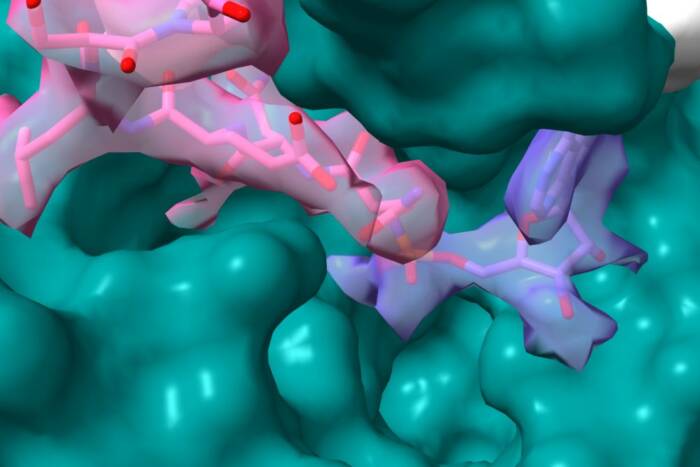More Studies Shed Light on How Prozac Works

Photo at left shows a section of a normal mouse brain after serotonin was administered to it; photo at right shows a section of a DARPP-32 knockout mouse after serotonin administration. Bright spots in the normal mouse indicate activation of a molecule called c-fos (which is used as a marker for serotonin activity). This activation is reduced in the DARPP-32 mouse, showing a role for DARPP-32 in the antidepressive effects of Prozac.
Nobel laureate Paul Greengard, Ph.D., and other Rockefeller University scientists have illuminated, in laboratory mice, new details of the complex chemical interaction in the brain that is generated by Prozac, the widely prescribed drug for depression.
Their findings are reported in a pair of papers in the March 5 issue of Proceedings of the National Academy of Sciences.
For many years, scientists have known that Prozac and similar “selective serotonin reuptake inhibitor” drugs boost the levels of the chemical messenger serotonin in the brain by blocking its reabsorption. But, serotonin levels alone could not be the only explanation for Prozac’s effectiveness in relieving symptoms of anxiety and improving mood in people suffering from depression.
Now, for the first time, Greengard and his Rockefeller colleagues have demonstrated that serotonin increases the effectiveness of glutamate, another key chemical messenger that acts as an on-off switch for nerve impulses.
“We now can explain that Prozac works on depression in part by increasing signaling through the glutamate pathway, but we don’t know why an increase in glutamate signaling alleviates depression in people,” says Greengard, Vincent Astor Professor and head of the Laboratory of Molecular and Cellular Neuroscience. “We know enormously more about how Prozac works than before we did this study, but we don’t have all the answers.
“The brain is such an incredible instrument to say that you know how it works would be nothing short of arrogance.”
The research reported in PNAS helps opens the door to a wider understanding of brain chemistry and its effects on depression and related health disorders.
An imbalance in the brain’s serotonin system plays a role in causing depression. Normally, a “sending” brain cell releases serotonin into what is called the synapse. This is the space between the axons of the “sending” nerve cell and dendrites of the “receiving” nerve cell. When serotonin reaches the surface of the dendrite, it stimulates or activates receptors that can interact only with this chemical messenger. Stimulation of these receptors generates an electrical impulse in the “receiving” cell that allows brain cells to communicate with each other. The serotonin is removed and recycled through a molecule on the “sending” cell that is called a serotonin re-uptake pump.
By blocking the action of the serotonin re-uptake pump, Prozac increases the amount of active serotonin that can be delivered to the dendrite. Scientists theorize that increased serotonin in the brain somehow helps restore normal message transmission among brain cells and thereby relieves symptoms of depression.
Serotonin is one of many neurotransmitters. Another chemical messenger, dopamine, affects brain processes that control movement, emotional response and ability to experience pleasure and pain. Abnormalities in dopamine signaling are associated with Parkinson’s disease, schizophrenia, attention deficit hyperactivity disorder and substance abuse. Because dopamine plays a role in these and other neurological and psychiatric disorders, Greengard and his research colleagues at Rockefeller University reasoned that this neurotransmitter may interact in some way with serotonin and thus regulate emotional behavior.
To probe this possible connection, the Rockefeller scientists turned to Prozac. They observed the effects of the drug in mice genetically altered to lack a protein called DARPP-32 (the mouse is called a “DARPP-32 knockout mouse”). Previous research by Greengard and his colleagues has shown that DARPP-32 is a major player in the mechanisms by which the neurotransmitter dopamine produces its effects in the brain.
The scientists found that the behavioral antidepressive effect and several other biochemical effects of Prozac were abolished when Prozac was administered to the DARPP-32 knockout mice.
“These results show for the first time an important role for DARPP-32 in mediating the actions of serotonin in mice,” says Per Svenningsson, Ph.D., first author of the scientific papers. “Moreover, the data provide the outline of a molecular mechanism for the behavioral actions of psychostimulants and antidepressant agents that achieve their effects through perturbation of transmission of serotonin.”
In the second PNAS paper, Svenningsson, Greengard and their colleagues mimicked the effects of Prozac observed in the DARPP-32 knockout mice in a test tube by applying serotonin to brain slices.
The Rockefeller University scientists discovered that Prozac and serotonin regulate protein phosphorylation at three distinct sites on DARPP-32. Proteins are activated through phosphorylation, the process by which a phosphate molecule is attached to a target protein. A phosphorylated protein, through one or more biochemical steps, produces the physiological response characteristic of neurotransmitters.
Interestingly, serotonin increases DARPP-32 phosphorylation at two sites, while decreasing phosphorylation at a third site. The researchers identified three serotonin receptors responsible for the changes in phosphorylation of DARPP-32. The three receptors work synergistically through DARPP-32 to block an enzyme called protein phosphatase-1 (PP-1). PP-1 regulates many crucial biological processes by dephosphorylating, or removing phosphate molecules, from phosphorylated proteins, thereby inactivating them.
“Inhibition of PP-1 means a lot of proteins won’t be dephosphorylated and thus that their physiological properties will be altered,” says Greengard. “Our next step is to identify these proteins and determine how PP-1 inhibition might be related to the action of antidepressant agents.”
The researchers focused on a target of PP-1 called AMPA, which is a receptor for the amino acid glutamate, the primary excitatory neurotransmitter in the mammalian central nervous system. Studies by other researchers have indicated that classes of drugs effective in animal models of depression also regulate the AMPA receptor, and other antidepressant drugs are known to work directly on glutamate to increase glutamate signaling. They found that increased glutamate activity resulted from a complex signaling cascade initiated by serotonin: serotonin activates DARPP-32, which inhibits PP-1, increasing AMPA receptor phosphorylation, which in turn increases the effectiveness of glutamate.
Svenningsson’s and Greengard’s co-authors are Eleni T. Tzavara, Jeffrey M. Witkin, Allen A. Fienberg, George G. Nomikos and Feng Liu.
This research was supported in part by grants from the U.S. Public Health Service.
John D. Rockefeller founded Rockefeller University in 1901 as The Rockefeller Institute for Medical Research. Rockefeller scientists have made significant achievements, including the discovery that DNA is the carrier of genetic information. The University has ties to 21 Nobel laureates, six of which are on campus. Rockefeller University scientists have received this award for two consecutive years: neurobiologist Paul Greengard, Ph.D., in 2000 and cell biologist Günter Blobel, M.D., Ph.D., in 1999, both in Physiology or Medicine. At present, 33 faculty are elected members of the U.S. National Academy of Sciences.


